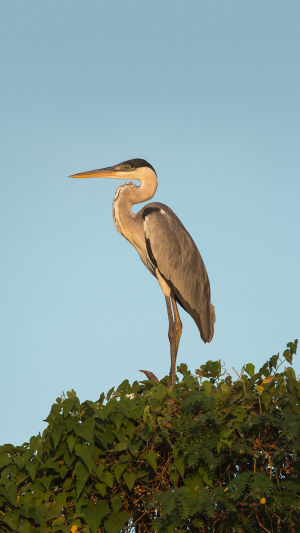The great blue heron is a large-sized wading bird of the genus Heron in the family Heronidae of the order Pelagiformes. It is found in North and Central America.
The great blue heron pierces fish or frogs with its long, pointed bill and swallows them whole, sometimes choking to death because its prey is too large.
It is similar to the heron, which is found in Eurasia and Africa.
The difference between the great blue heron and the heron is that the heron is smaller than the great blue heron and has a different color head and bill.
Geographical distribution
The Great Blue Heron is found in North America, Central America, the West Indies, and the Galapagos Islands.
The Great Blue Heron can be found throughout most of North America, including Alaska, Quebec, and Nova Scotia.
The southern boundary can reach Florida, Mexico, the Caribbean, and as far as South America.
Populations east of the Rocky Mountains to the north migrate to Central America or northern South America each winter. Populations in the southern United States and on the Pacific coast are resident birds.
Habitat
Generally live in areas including fresh and brackish marshes, mangroves, floodplains, and lakeshores. Need to live off the water.
They generally nest in woods or shrubs near bodies of water. The call of the Great Blue Heron is a rough croak.
Great Blue Herons do not forage in groups. They usually stand in the water looking for targets, but will also leap from the ground or the air or a perch.
Because of their large size, they can feed in deeper water where other herons cannot reach.
Growth and breeding
Great Blue Herons often nest in trees near lakes or wetlands, forming colonies containing only a single species, but sometimes they mix with herons belonging to other species.
The size of a colony ranges from about 5 to 500 nests, with an average of 150 nests per colony.
Great Blue Heron nests are made up of sturdy branches, Females lay three to six light blue eggs in the nest.
The parents raise only one chick per year. They regurgitate their food. Adults consume four times as much food during feeding as they do when laying or incubating eggs.
If the nest is abandoned or destroyed, the female will lay another nest of eggs.
Heron eggs take 28 days to hatch, with each egg hatching a few days apart from the other.
First-born chicks usually grow faster than other chicks due to their greater feeding experience and more aggressive behavior toward their siblings.





